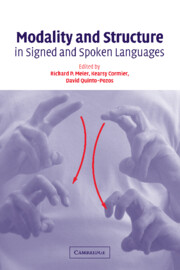Book contents
- Frontmatter
- Contents
- List of figures
- List of tables
- List of contributors
- Acknowledgements
- 1 Why different, why the same? Explaining effects and non-effects of modality upon linguistic structure in sign and speech
- Part I Phonological structure in signed languages
- Part II Gesture and iconicity in sign and speech
- Part III Syntax in sign: Few or no effects of modality
- 10 Where are all the modality effects?
- 11 Applying morphosyntactic and phonological readjustment rules in natural language negation
- 12 Nominal expressions in Hong Kong Sign Language: Does modality make a difference?
- Part IV Using space and describing space: Pronouns, classifiers, and verb agreement
- Index
- References
11 - Applying morphosyntactic and phonological readjustment rules in natural language negation
Published online by Cambridge University Press: 22 September 2009
- Frontmatter
- Contents
- List of figures
- List of tables
- List of contributors
- Acknowledgements
- 1 Why different, why the same? Explaining effects and non-effects of modality upon linguistic structure in sign and speech
- Part I Phonological structure in signed languages
- Part II Gesture and iconicity in sign and speech
- Part III Syntax in sign: Few or no effects of modality
- 10 Where are all the modality effects?
- 11 Applying morphosyntactic and phonological readjustment rules in natural language negation
- 12 Nominal expressions in Hong Kong Sign Language: Does modality make a difference?
- Part IV Using space and describing space: Pronouns, classifiers, and verb agreement
- Index
- References
Summary
Introduction
As is well known, negation in natural languages comes in many different forms. Crosslinguistically, we observe differences concerning the morphological character of the Neg (negation) element as well as concerning its structural position within a sentence. For instance, while many languages make use of an independent Neg particle (e.g. English and German), in others, the Neg element is affixal in nature and attaches to the verb (e.g. Turkish and French). Moreover, a Neg particle may appear in sentence-initial position, preverbally, postverbally, or in sentence-final position (for comprehensive typological surveys of negation, see Dahl 1979; 1993; Payne 1985).
In this chapter I am concerned with morphosyntactic and phonological properties of sentential negation in some spoken languages as well as in German Sign Language (Deutsche Gebärdensprache or DGS) and American Sign Language (ASL). Sentential negation in DGS (as well as in other sign languages) is particularly interesting because it involves a manual and a nonmanual element, namely the manual Neg sign NICHT ‘not’ and a headshake that is associated with the predicate. Despite this peculiarity, I show that on the morphosyntactic side of the Neg construction, we do not need to refer to any modality-specific structures and principles. Rather, the same structures and principles that allow for the derivation of negated sentences in spoken languages are also capable of accounting for the sign language data.
On the phonological side, however, we do of course observe modality-specific differences; those are due to the different articulators used.
- Type
- Chapter
- Information
- Modality and Structure in Signed and Spoken Languages , pp. 263 - 295Publisher: Cambridge University PressPrint publication year: 2002
References
- 29
- Cited by



